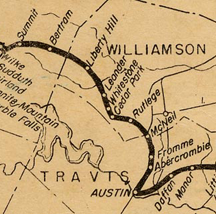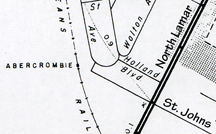Copyright 2011-2022 Susan Burneson. All rights reserved. Kindly talk with us before reproducing any website content.
 In 1838, George West Spear, an early Texas settler, acquired more than 4400 acres in what would later become Central and West Austin. Spear’s land was roughly between the Colorado River and Anderson Lane, and from Lamar Boulevard to west of Shoal Creek.
In 1838, George West Spear, an early Texas settler, acquired more than 4400 acres in what would later become Central and West Austin. Spear’s land was roughly between the Colorado River and Anderson Lane, and from Lamar Boulevard to west of Shoal Creek.
More than 100 years later, in the late 1940s, the Crestview neighborhood began to be developed in the northeast part of the Spear League (seen in the lower right corner of the map, above). For many years, many maps of the area, including those showing railroad stops, have included a mysterious populated place, Abercrombie, near today’s Capital Metro rail station at Justin and Lamar.
In 1881, the Austin and Northwestern narrow gauge railroad was constructed between Austin and Burnet, along the northeastern corner of today’s Crestview. The railroad began carrying passengers in 1882.
Northwestern narrow gauge railroad was constructed between Austin and Burnet, along the northeastern corner of today’s Crestview. The railroad began carrying passengers in 1882.
Three years later, the owners of Granite Mountain west of Marble Falls offered to donate granite for the building of the Texas State Capitol, and the rail line was extended from Burnet to the mountain. By the time the Capitol was completed in 1888, 16,000 carloads of Sunset Red granite had passed through what is now Crestview and the rail stop called Abercrombie.
A 1948 map (below) shows Abercrombie west of the intersection of North Lamar and St. Johns, which was then several miles north of the Austin city limits. Back then, Justin Lane didn’t exist, and West St. Johns ran between North Lamar and the railroad track.
 On the site of today’s Crestview Station development, other streets, including Holland and Walton, were part of a planned subdivision called Hollandale that was never built.
On the site of today’s Crestview Station development, other streets, including Holland and Walton, were part of a planned subdivision called Hollandale that was never built.
By 1948, the Austin and Northwestern line had become part of the Texas and New Orleans railroad, and in 1961 the T&NO was absorbed by Southern Pacific. A 1962 Southern Pacific railroad schedule still showed Abercrombie as one of its stops. By then, it likely carried freight only.
Today, United States Geological Survey (USGS), Google, and other maps found online still include a populated place with the name Abercrombie in Travis County, although long ago it became part of the City of Austin. The USGS has no information about the town’s history, how it was named, or why it still appears on its online maps.
In 2006, I first saw local television meteorologists point out Abercrombie on a map, as they announced when a storm would reach various locations in the Austin area. When I asked about it, one meteorologist told me that even the latest electronic maps still include ghost towns or other locales that now exist in name only.
Official railroad records indicate that the original site of the town called Abercrombie was on the northeast corner of Airport and Lamar. Back then, the railroad laid out towns along rail lines in hopes of attracting settlers. Towns and train stops typically were named for investors and prominent citizens.
So, who might have inspired the naming of Abercrombie?
Maybe it was John Abercrombie, a farmer, who moved with his family to Texas about 1855 and purchased property north of 45th Street in Travis County. By 1870, Sarah was a widow; John may have died during the Civil War. At least for the next ten years, when land was being acquired for the new railroad, Sarah and several of her children still lived in Travis County. From 1900 until at least 1920, Sarah lived in Killeen with her son Joe, who worked for the railroad, and other family members.
Possibly, Abercrombie was named for Leonard Anderson Abercrombie, a Texas lawyer, Confederate Army officer, and legislator. During the Civil War, he served as a lieutenant colonel in the Twentieth Texas Infantry, one of the largest regiments formed in the state. According to the Handbook of Texas Online, “This regiment, organized in the spring of 1862, was composed primarily of middle-aged men, many of whom were prominent citizens.” Any one of them might have suggested that the new town just north of the capital city be named Abercrombie in his honor. Abercrombie’s daughter Lavinia married Robert Scott Lovett, considered one of the leading railroad lawyers in Texas beginning in the 1880s. Lovett also might have influenced the naming of the town in honor of his wife’s family.
Most likely of all, Abercrombie, the populated place within a neighborhood, will remain something of a mystery.
